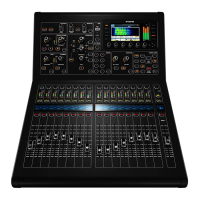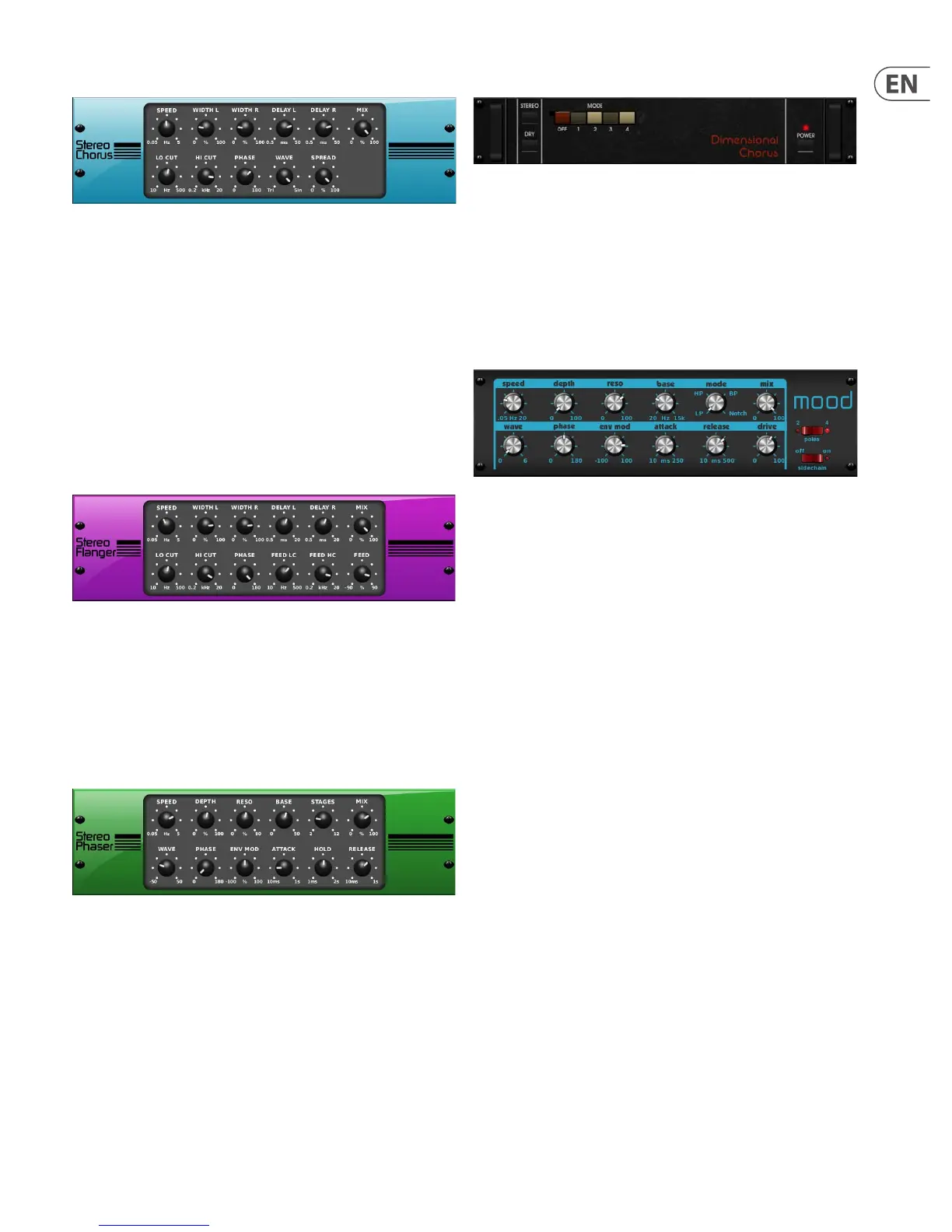43 DIGITAL RACK MIXER M32R User Manual
Stereo Chorus
Chorus samples the input, slightly detunes it and mixes it with the original
signal to produce a somewhat thicker, shimmering sound. Use it to thicken up
background vocals, or to double the sound of brass and woodwind instruments.
Whereas DELAY L / R set the total amount of delay for the left and right
channels, WIDTH L / R determines the amount of modulated delay taken from
either the left or right channels. SPEED sets the modulation speed, MIX adjusts
the balance of dry and wet signals. You can further sculpt the sound by trimming
some of the low- and high-end of the aected signal with the LO CUT and
HI CUT push encoders. Additionally the PHASE push encoder can tweak the
phase oset of the LFO between left and right channels, and the SPREAD push
encoder adjusts how much of the left channel is mixed into the right, and vice
versa. Finally the WAVE push encoder blends between the ‘Danish’ style digital
triangular chorus sound and the classic analogue sine wave.
Stereo Flanger
The Flanger emulates the phase-shifting sound (comb-ltering) originally created by
applying pressure against the ange of the reel on a tape recorder. This eect creates
a unique ‘wobbly’ sound that is quite dramatic when used on vocals and instruments.
The controls of this eect are nearly identical to the controls on the Chorus eect
block. Additionally, the FEEDBACK can be adjusted with positive and negative
amounts, and also band-limited with the FEED HC (high-cut) and FEED LC
(low cut) push encoders.
Stereo Phaser
A Stereo Phaser, or phase shaper, applies multiple STAGES of modulated lters to
the input signal to create a ‘notch’ in the frequency response, and then applies a
MIX with the original for a ‘swirling’ eect. Use the M32’s Stereo Phaser to add a
‘spaced-out’ sound to vocal or instrumental tracks.
SPEED sets the LFO rate and DEPTH sets the LFO modulation depth.
The BASE push encoder adjusts the frequency range of the modulation lters.
The resonance is adjusted with the RESO push encoder. STAGES determines the
number of times the audio signal is processed by the eect. MIX determines how
much of the aected signal is present in the output audio.
The WAVE push encoder shapes the symmetry of the LFO waveform, and
PHASE dials in an LFO phase dierence between the left and right channels. The
modulation source can also be the signal envelope, which produces vowel-like
opening and closing tones. The ENV MOD push encoder adjusts how much of this
eect takes place (positive and negative modulation is possible), and the ATTACK,
HOLD and RELEASE push encoders all tailor the response of this feature.
Dimension-C
Chorus samples the input, slightly detunes it and mixes it with the original
signal to produce a somewhat thicker, shimmering sound. Use it to thicken up
background vocals, or to double the sound of brass and woodwind instruments.
Inspired by the Roland Dimension D.
Turning the rst push encoder to toggle the output signal between Mono
and STereo. Pressing the rst encoder turns the eect on or o. Pressing the
second encoder turns dry mode on or o. Pressing the third, fourth or fth push
encoders engages the chorus eect with increasing intensity.
Mood Filter
The Mood Filter uses an LFO generator and an auto-envelope generator to
control a VCF (voltage-control lter), as well as a side-chain function, where
the channel B signal controls the envelope of channel A. When applied to
electronic instruments, the Mood Filter can be used to emulate the natural sound
of acoustic instruments. Inspired by the MiniMoog.
This lter can be modulated with the signal’s envelope using the ENV MOD (with
positive and negative amounts), ATTACK and RELEASE push encoders, or the LFO
can modulate the lter. The WAVE push encoder selects between seven dierent
waveforms - triangular, sine, saw plus, saw minus, ramp, square and random.
The PHASE can be oset by up to 180°. The SPEED push encoder adjusts the
rate of the LFO, and DEPTH adjusts the amount of LFO modulation. Adjust the
resonance of the lter until self-oscillation with the RESO(nance) push encoder.
BASE adjusts the range of the lter from 20 Hz to 15 kHz. The MODE switch
selects between low-pass (LP), high-pass (HP), band-pass (BP) and Notch.
Use the MIX push encoder to blend the aected signal with the dry sound.
With the 4 POLE switch engaged there will be a steeper slope than the 2 POLE
setting. The DRIVE push encoder adjusts the level, and can also introduce an
overdrive eect (as with real analogue lters) if pushed hard. In Side-chain mode,
only the left input signal is processed and fed to both outputs. The envelope of
the right input signal can be used as a modulation source. Applying the SIDE
CHAIN function ensures that the parameters of the eect are changed based on
an external stimulus signal.

